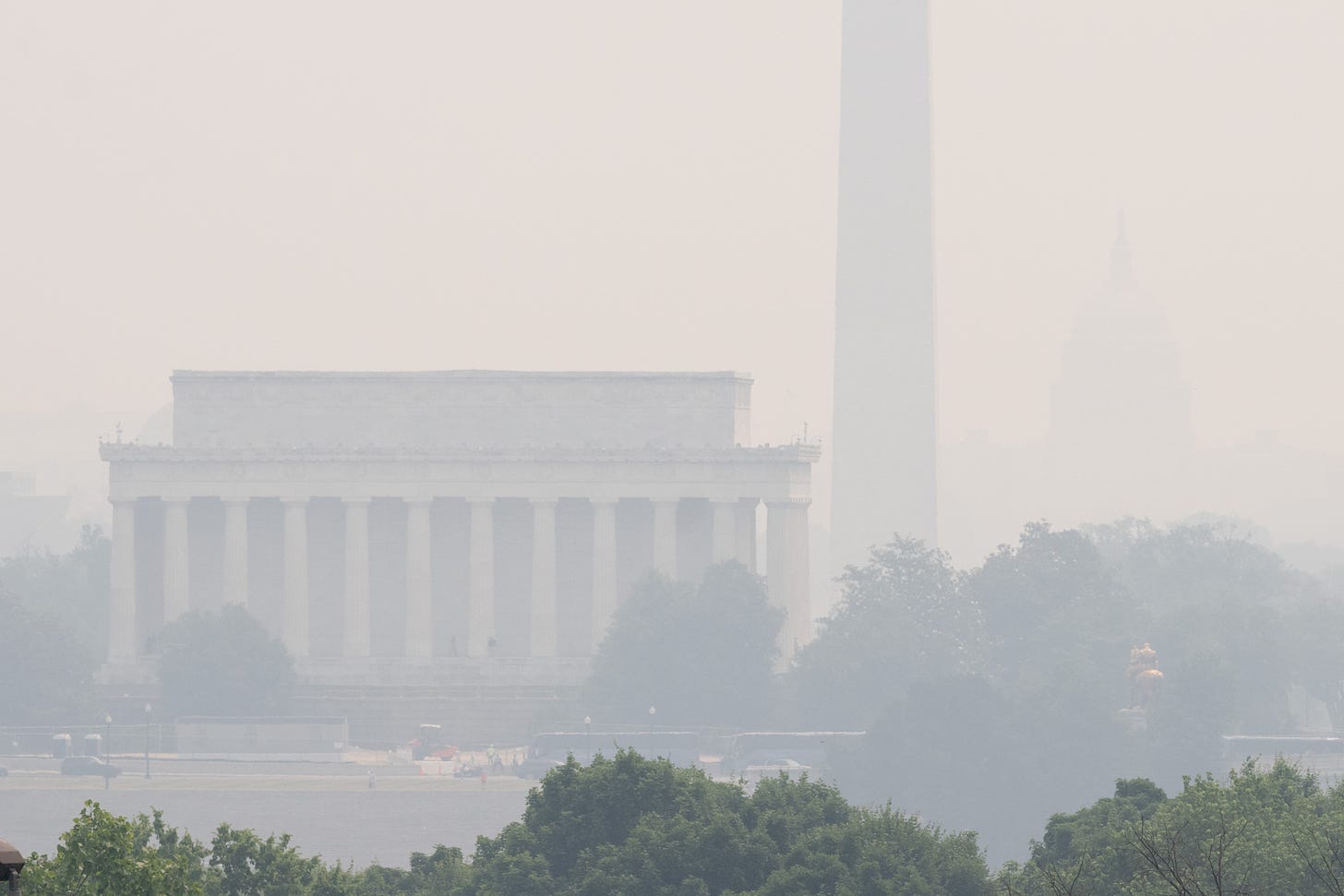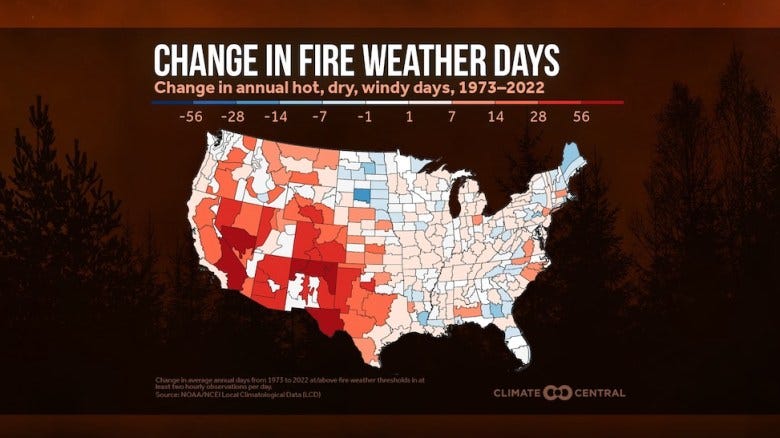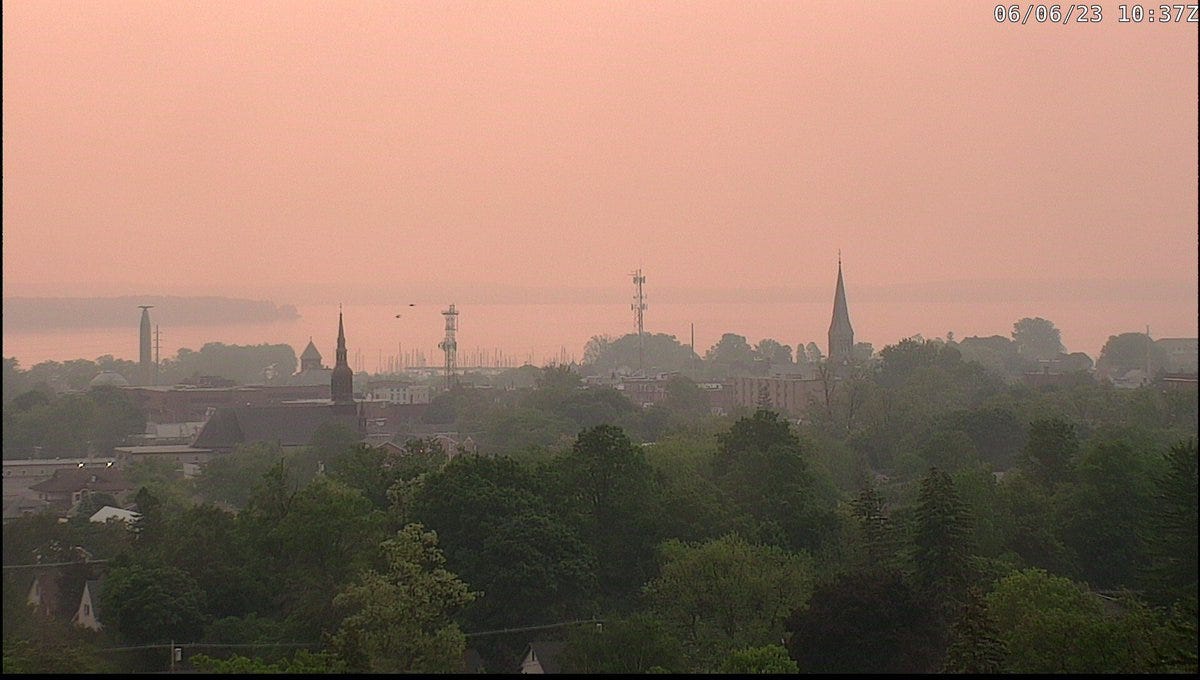I live in Vermont, where the scent of woodsmoke on a late fall afternoon is an iconic smell. It’s not like that here today—it’s more like sitting on the side of the campfire where the wind is blowing, but without any of the benefits of the blaze. The air is a dull gray, and the sunshine through it looks and feels diminished, as if from a different star circling a different planet. My chest is tight, and I keep bringing up phlegm.
And I’m lucky. The air is worse in New York and in D.C.—indeed, across the east cities are breaking all-time pollution records. (I imagine it was smokier back in the early Industrial Revolution, but we weren’t measuring it).
And we’re all lucky. Because this is what a huge percentage of the world’s people breathe every single day of their lives. In fact, we should probably—in our hearts if not our lungs—be grateful for a few days like this. They bring us much much closer to the lived experience of billions of our brothers and sisters.
In the case of the eastern U.S. today, the smoke—and the dangerous particulates it carries—comes from Canadian wildfires. They are a result of the hot dry weather that climate change has made more likely. It began out west earlier in the spring, as parts of Alberta turned into an inferno. And then, as the go-to meteorologists Bob Henson and Jeff Masters reported today,
By late May and early June, the dangerous fire weather extended into the moister climates of Ontario and Quebec — and even the Canadian Maritimes — as lush trees and grasses became tinder-dry amid severe drought and heat.
It’s not just Canada, of course. A new analysis released last week by Climate Central analyzed the fifty-year shift towards more severe fire seasons
“Southern California, Texas, and New Mexico have experienced some of the greatest increases in fire weather days each year, with some areas now seeing around two more months of fire weather compared to a half-century ago,” the report noted. It added: “Even small increases in fire weather in the East, which has nearly 28 million homes located in zones prone to burn, puts more people at risk.”
But here’s the thing. There’s nothing particularly special about wildfire smoke. Today in Vermont feels like a hundred days I’ve spent in New Delhi, in Shanghai, in Beijing, in Ahmedabad. Many of those were much worse: I’ve stood on Connaught Place and not been able to see the giant Indian flag flapping in Delhi’s Central Park, even though I knew if was a few hundred feet away at most.
That smoke doesn’t come from forest fires. It comes mostly from burning fossil fuels. But it’s all combustion, and it all does the same thing to your lungs. There are four and a half million children in New Delhi, and the estimate is that half of them have irreversible lung damage from breathing the air. Around the world, nine million deaths a year—one death in five—comes from breathing the combustion byproducts of fossil fuel. About a third of all deaths in Asia come from breathing fossil fuel pollution.
If the climate crisis is the great existential crisis on our earth, then smoke is the great daily crisis. Happily, they’re both caused by the same thing: burning coal and gas and oil. And even more happily, we know how to end it. We just stop burning stuff, and rely instead on the fact that there’s a large ball of burning gas at a safe 93-million-mile distance. We get all the fire we could ever want, and none of the smoke. Call it “external combustion.”
This is entirely doable—solar power is the cheapest way to make energy on earth. If someone tells you they don’t want to look at a solar panel, or that mining required for a wind turbine does environmental damage, it’s fine to see their point. But everything is relative. Today is our chance to understand what it really feels like every day on a fossil-fueled planet, for the billions of people unlucky enough to really bear the brunt. My eyes are stinging a bit from the smoke, but I’ve never seen more clearly. Everything is in perspective, even—especially—through the haze.
Here’s what it looks like in Burlington Vermont this afternoon. Eventually the wind will shift and it will clear. But it will look like this most days in most Asian cities this year and every year, until we beat the fossil fuel lobby.
In other energy and climate news:
+The chair of the Intergovernmental Panel on Climate Change issues a timely warning that carbon capture and storage is not a “free lunch.” Hoesug Lee noted
that the IPCC had found it was likely that global temperatures could rise by more than 1.5C above pre-industrial levels but could then be made to return to below 1.5C by the end of the century. “The jargon for that is the overshoot,” he said. “Carbon dioxide removal methods will be much in demand if that overshoot indeed occurs.”
“But there will be a cost to doing that. There’s no free lunch. And that cost includes that the longer the period of overshoot, there will be additional global warming, and there will be consequences of increased warming. There is also the possibility of positive feedback from that additional warming, creating more losses and damages during the overshoot period,” he warned. “So one wishes to avoid such an overshoot scenario.”
+The Center for American Progress reminds us that one of the better features of the Inflation Reduction Act is that it doesn’t depend entirely on tax credits, which are mostly useful to the wealthy. Instead, people putting up projects can qualify for “direct pay.”
This process allows entities exempt from income tax—such as nonprofits, state/local/Tribal governments, publicly owned utilities, and rural electric cooperatives—to claim the equivalent amount of tax credit in the form of a direct payment from the IRS. This enables tax-exempt entities to take advantage of clean energy tax credits for the first time.
+Keith Schneider tells the remarkable story of the Iowa power structure cracking down on an academic, Chris Jones, who dared to tell the truth (and with great humor and power) about how Big Ag pollutes the state’s water.
Jones’ assessment, based on continuous monitoring from streams and rivers — what university administrators called “the backbone” of the nutrient strategy — was consistent and unassailable. Not only is the reduction strategy not working, he reported, the state’s ever more intensive industrial farm practices are pouring more nutrients into Iowa’s streams and rivers. Water pollution is getting worse.
“So here’s what’s behind the killing of the blog and the sensor network,” said Jones in an interview. “These guys now are going to own all the messaging. They’re going to be able to say whatever they want about progress towards nutrient management goals. There’s not going to be anyone here to do these calculations and use the sensor data to draw conclusions about what’s in the water.”







Also, it is so clear what we need to do, and yet we’re not doing it. So many of us feel an intense sense of frustration that nothing is happening on the scale required to reverse or even stop the planetary damage.
That Keith Schneider report on Iowa is sobering and important. It reminded me right away of GOP and former Virginia attorney general Ken Cucinelli's attack on climate scientist Michael Mann here at UVA some years ago (Mann is now at Penn). The GOP is systematically harming America and Americans for short-term profits and power. Thank you for keeping us informed.